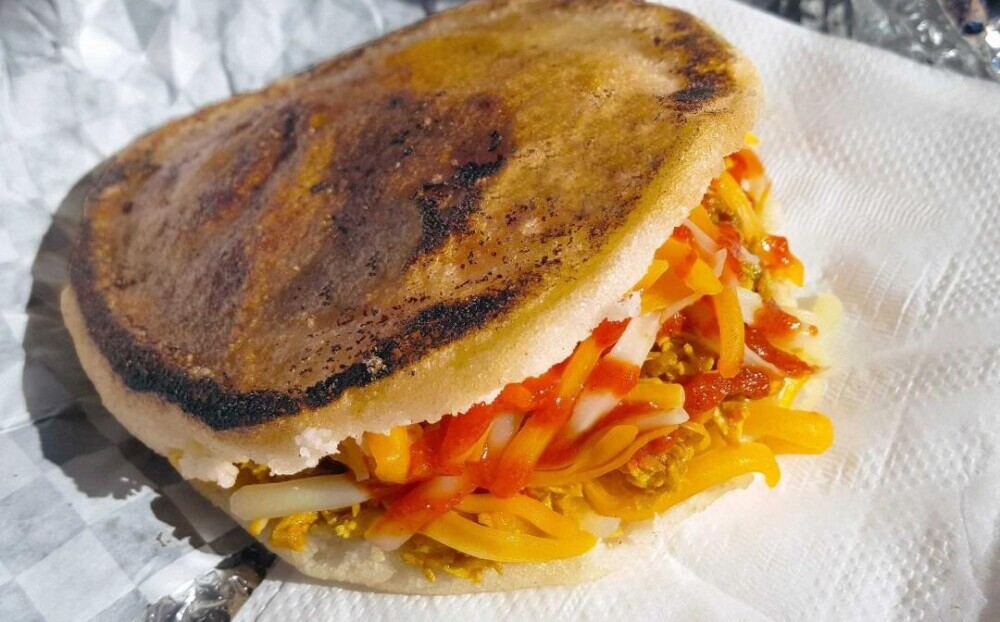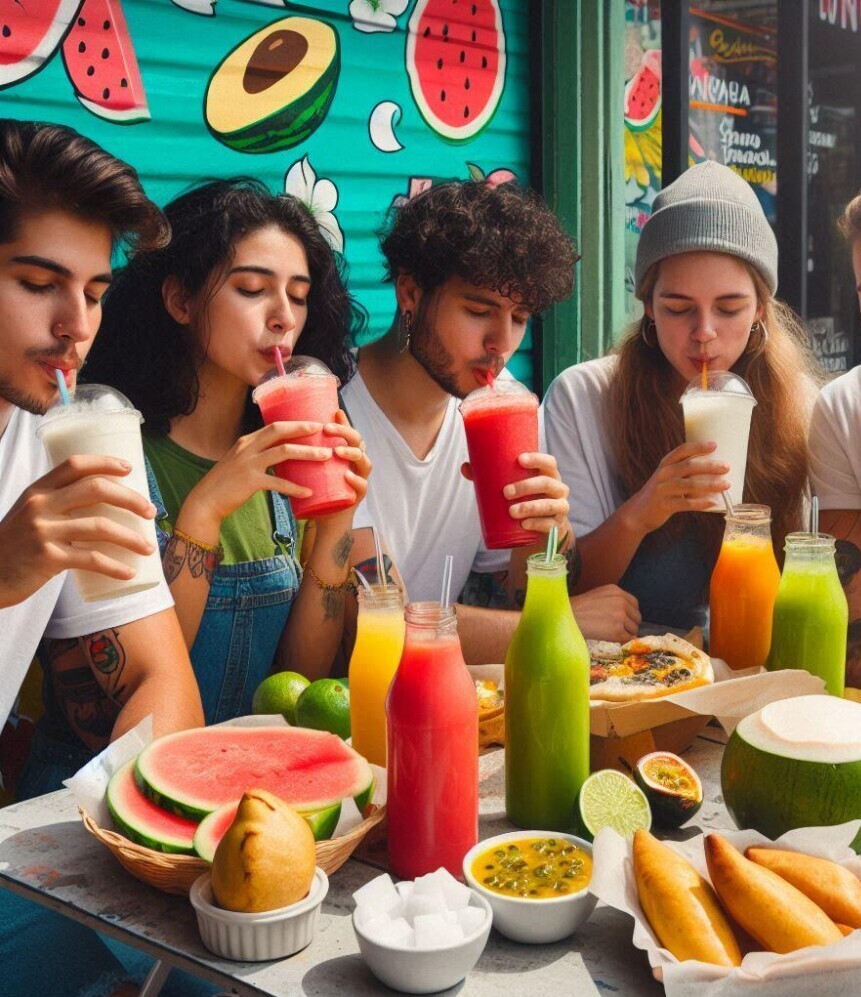My website contains affiliate links. This means if you click and make a purchase, I may receive a small commission. Don’t worry, there’s no extra cost to you. It’s a simple way you can support our mission to bring you quality content.
Street food is a staple for most Colombians.  Everywhere in the nation, from parks and metro stations to busy intersections, you’ll find vendors selling delicious fruits and all manner of corn manifestations and meat-filled treats. Sampling these goodies is a great way to familiarize yourself with Colombian culture and feel like one of the locals. You’ll also develop a taste for native ingredients and regional dishes. Colombian street food varies from region to region, so an arepa or tamale in one region won’t be the same as in another. This is a wonderful way Colombians use to make a living! ?
Everywhere in the nation, from parks and metro stations to busy intersections, you’ll find vendors selling delicious fruits and all manner of corn manifestations and meat-filled treats. Sampling these goodies is a great way to familiarize yourself with Colombian culture and feel like one of the locals. You’ll also develop a taste for native ingredients and regional dishes. Colombian street food varies from region to region, so an arepa or tamale in one region won’t be the same as in another. This is a wonderful way Colombians use to make a living! ?
Corn-based foods rule the street food scene in Colombia. The most iconic is the arepa, a thick corn cake that’s griddled, baked, or grilled, and then stuffed with everything from cheese to meats to avocado. Different regions offer unique twists on this classic, so try them all if you can! In coastal areas, you might find arepas de huevo—fried arepas filled with egg and minced meat. Up in the Andes, arepas are often simpler, letting the natural corn flavor shine through.


Use your imagination and try this wonderful Arepa Pork Chop Meat Recipe:
Ingredients:
- Warm water- At least 1 Cup
- Cornmeal- 1 cup of pre-cooked cornmeal such as (P.A.N.)
- Pork chop meat, diced or cut in pieces
- Add 1 cup of Mozzarella cheese
- Butter – At Least 1 tablespoon
- Tomatoes
- Add salt to taste, starting with ½ teaspoon(Add more as needed)
Instructions:
- Combine ingredients: In a large bowl, mix the warm water, cornmeal, mozzarella cheese, butter, and salt. Knead until a soft dough forms.
- Shape arepas: Divide the dough into medium-sized balls. Roll each ball into a disc about ½ inch thick.
- Cook arepas: Heat in a griddle or skillet over medium-high heat. Lightly grease the surface.
- Fry the diced or cut pork in a skillet or frying pan over medium heat until browned or fully cooked.
- Add your pork chops and tomatoes and cook the arepas for about 5 minutes per side until they turn golden brown.
- Serve: Enjoy your freshly cooked arepas warm. They’re delicious on their own or with toppings like butter, cheese, or avocado.

These scrumptious arepas are versatile and can be enjoyed for breakfast, as a side dish, or as a quick snack. Enjoy! ?
Tamales are another must-try. Wrapped in banana leaves, these little parcels are packed with spiced meats, peas, carrots, and sometimes, whole eggs. The fillings and the style of tamale preparation change as you move across the country. In the Tolima region, the tamales are generously stuffed and boast a unique flavor bowing to local seasoning.
Tolima-Style Tamales Recipe:
Yields: 12 tamales Prep time: 1 hour Cook time: 1-2 hours
Ingredients:
For the filling:
- 2 pounds of pork ribs, chopped into small pieces
- 1 pound of pork belly, diced into small pieces
- Take one whole chicken and cut it into pieces
- Cooked white rice(1 pound )
- Green peas fully Cooked(1 cup)
- Fully cooked sliced carrots(1 cup )
- Take 6 hard-boiled eggs, and cut them in half
- Season with salt and pepper as desired
- Use Your preferred spices (e.g., cumin, paprika, chili powder)
For the masa or dough:
- 2 cups of flour-based dough
- 2 cups of heated water
- 4 tablespoons of vegetable oil (or 1/4 cup )
- 1 teaspoon baking powder
- 1/2 teaspoon salt
For wrapping:
- 12 large or properly sized banana leaves. If Banana Leaves aren’t available, you may use Corn Husk, Parchment Paper, or Aluminum Foil. You can purchase these at your local grocery store, online, or at Farmers’ Markets.
Instructions:
- Prepare the filling: Boil the pork ribs, pork belly, and chicken with water in a large pot until the meat is tender for about 1-2 hours. Afterward, remove the meat from the pot and shred it.
- Make the masa(dough): Mix the masa harina(dough), warm water, vegetable oil, baking powder, and salt in a large pot until everything is smooth.
- Assemble the tamales: Place the masa(dough) on a banana leaf on a flat surface, and add some shredded meat, rice, peas, carrots, and egg. Wrap or fold each banana leaf around the filling and secure it with string or a toothpick.
- Cook the tamales: Steam your tamales in a steamer or large pot with a steamer basket. Cover it and let the water boil for 1-2 hours until your tamales are thoroughly heated.
- Serve: Enjoy the tamales hot with a dipping sauce like spicy tomato or creamy avocado-lime, green chile sauce or Tomatillo Sauce.
Note: Feel free to customize the filling ingredients to your liking. Some folks like to add potatoes, corn, or olives to their tamales. ??
Enjoy your delicious Tolima-style tamales!

The cultural significance of indulging in street food can’t be overstated. It’s not just about eating; it’s a vibrant social experience. Imagine standing by a food cart, chatting with locals, and watching the hustle and bustle of Colombian life unfold around you while you savor every bite. It’s the best way to connect with the culture and community.

Worried about safety? Rest easy: most food vendors in Colombia take huge pride in their stands. They’ve often been in business for years, passed down through generations, and they know that keeping things clean is essential to their success. The competition is fierce, so if a spot isn’t up to par, it won’t last long. Go where the locals go, and you should have a tasty and safe experience.
When traveling to Colombia, enjoying street food can be a delightful experience. Here are some tips to help you choose safe street food vendors and avoid common health risks:
- Look for Busy Stalls: Vendors with long lines and high turnover are likely to have fresher food. High customer traffic often indicates good quality and safety.
- Check for Cleanliness: Observe the vendor’s hygiene practices. Make sure they use gloves, hairnets, and clean utensils. The preparation area should always be neat and free from pests.
- Inspect the Food: Fresh ingredients and properly cooked food are key. Avoid foods undercooked foods and food that looks like it has been sitting out for a long time.
- Ask Locals for Recommendations: Locals can guide you to reputable vendors with safe and delicious food.
- Avoid Raw Foods: Stick to cooked foods to minimize the risk of foodborne illnesses. Be cautious with raw fruits and vegetables; be sure they are peeled and washed with clean water.
- Check for Permits: In Colombia, street food vendors are required to have a food handler’s permit, indicating they have undergone training on proper food handling, storage, and preparation.
- Stay Hydrated with Bottled Water: Drink bottled water instead of tap water to avoid potential contamination.
Refreshing Beverages and Sweet Treats
When it’s time to quench your thirst in Colombia, you’re never far from a fruit-juice stall. The sheer variety of options available is mind-boggling. You’ve got everything from familiar favorites like sandia (watermelon) to unique blends like limonada de coco (coconut milk and lime with ice). These juices are typically made to order, so you can customize them with water or milk, and with or without sugar.
Colombia is home to fruits you might never have encountered before. Give exotic choices like guanábana, lulo, and maracuyá (passion fruit) a try. These fruits offer flavors that are truly unforgettable and often refreshing in ways you can’t imagine until you’ve tried them.
Regional specialties add even more depth to the street food scene. In Cali, champus, a mix of corn, lulo, pineapple, and sometimes other fruit, is thick enough to eat with a spoon. Meanwhile, in the Valle del Cauca region, cholados blend lulo with condensed milk, ice, and sugar for a sweet treat you’ll crave again and again. Both are refreshingly unique and give you a taste of local traditions.
When choosing where to grab a drink, just follow the locals. Lines at fruit-juice stalls usually mean fresh, delicious, and safe options. So go ahead, let your taste buds explore these vibrant, fruity flavors.

You can also find , a rainforest fruit from the western Chocó region, often sold near soccer stadiums. This unique fruit is used to make jugo de amor, a ‘love juice’ believed to have aphrodisiac properties. Perfect for celebrating a win or just trying something completely new!
Borojó: A Colombian Superfruit
Borojó is a unique and flavorful tropical fruit native to Colombia, particularly found in the Pacific coast region. It’s known for its vibrant purple color, sweet and slightly tart taste, and numerous health benefits. Some Columbians refer to this fruit as the “Colombian Viagra” due to its aphrodisiac properties. The people of Columbia are fascinated with Borojó Juice‘s benefits such as:
- Nutrient-Dense: Full of essential vitamins, minerals, and antioxidants.
- Flavor: A refreshing blend of tangy and sweet.
- Texture: Typically enjoyed with a thick, viscous consistency.
- Culinary Favorite: A popular and beloved beverage in the Colombian cuisine.

Also known in Columbia as the “the love juice” Try this Borojó Juice Recipe
Ingredients:
- 2-3 Borojó fruits – If they are not available locally, you might be able to find it at specialty tropical fruit markets or through online retailers.
- 1 cup water
- Sweetener (optional, such as honey or agave nectar)
- Ice
Instructions:
- Prepare the fruit: After cutting the Borojó fruits in half, remove the seeds.

- Blend: Combine the Borojó with water, and optional sweetener in a blender. Blend until the mixture is smooth.

- Optional: For a smoother texture drain the Borojó
Afterwards: Enjoy your Borojó iced drink! ?

? What are you waiting for? ?
Colombia’s vibrant street food scene offers a culinary adventure unlike any other. From the savory delights of arepas and tamales to the refreshing flavors of exotic fruits, there’s something to tantalize every taste bud. ??
Don’t just be a tourist; be a traveler. ? Immerse yourself in the local culture by sampling street food, connecting with locals, and experiencing the unique flavors of each region. ?️?
So, next time you find yourself in Colombia, step away from the tourist traps and head to the nearest street food vendor. You won’t regret it! Enjoy your culinary journey! ??♂️?
This post contains a disclaimer. Read my full Disclaimer
